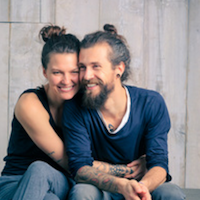
I’m a neurotic eater.
It’s not my fault really. It’s not my parent’s fault either. They served us home-cooked meals made from mostly whole, real foods. We didn’t eat sitting in front of the TV. We didn’t even have a TV.
But somewhere along the way, the commercial food industry weaseled its way into my stomach. By the time I got to high school, and had a little bit of my own pocket money, I firmly believed that a package of Twizzlers and a liter of chocolate milk was a perfectly good lunch.
I suppose theoretically I had the information to know better—at the very least I’d been made aware of the Canada Food Guide, whatever that’s worth. But what do 15-year olds really know, other than that they are immortal. A decade and a half later, I have a solid handle on what actually constitutes a healthy diet, as well as the effect of diet on mortality.
And yet, if I had to describe my relationship with food in just two words they would be: sugar and guilt.
What makes me moderately comfortable about this neurosis is that I am not alone. We, as a culture, kind of suck at eating.
The thing is, I really do love food. I love its variety and seasonality. I love the rituals and traditions of eating, the way food can remind me of places and people I’ve loved, the way I can come to know new cultures through food.
I just want to know how to love eating food better.
I recently had the chance to spend a week at Plum Village, a monastery founded by the Zen-Buddhist Thich Nhât Hańh, in France. All aspects of life at Plum Village are centred on mindfulness—we meditated mindfully, walked mindfully, cleaned toilets mindfully. And we ate mindfully. Of all the things that touched me over the course of the week, the mindful eating reached deepest.
Mindful eating is not a diet but rather a way of reshaping our relationship to food.
It includes no strict rules about what or when to eat. There are some broad recommendations: eat three meals at roughly the same time of day each day, commit as much as possible to a vegetarian or vegan diet, and avoid sugar and highly processed foods. Above all else, pay attention.
Obviously this is easy at a Zen monastery where everyone else is eating mindfully and there are no chocolate bars. I did it very well for a week. And then I got home and had to start all over, with much looser expectations.
I’ve found the five principles of mindful eating used at Plum Village to be the most useful guide. Consider reading these at the beginning of each meal. And try committing, at least some of the time, to spending the first 20 minutes of your meal in silence.
1. “This food is a gift of the whole universe—the Earth, the sky, numerous living beings and much hard loving work.”
Visualize the ingredients of your meal as they exist in nature. In your mind’s eye, see where each grows, what the whole plant looks like. Do you know what it looks like? Do you know what’s in what you eat? Feel the warmth of the sunlight, the coolness of rain that coaxed this food to life; the wind that scattered its seeds.
Can you trace your food from farm to table? What processes have the ingredients undergone to become the food you are eating? How did it arrive on your plate? Who helped to make it? Who supported the people who made your food? Can you see the whole web? Can you appreciate its infinity?
2. “May we eat with mindfulness and gratitude so as to be worthy to receive this food.”
Appreciate again the enormity of that web. Consider how your food choices might help or hurt others. Extend gratitude to the living beings that enable you to receive this food.
3. “May we recognize and transform unwholesome mental formations, especially our greed, and learn to eat with moderation.”
Take a moment to observe the food before you. See its color and texture. Take in its smell. Notice your desire for this food. Watch how your body prepares—salivates, signals. Take a spoonful slowly toward your mouth. Watch your impulse to rush. See what your mind does, what your body does, what your emotional heart says, as you take this bite into your mouth.
Are you in this moment still? What attachments arise? Does this food trigger memories? Are those memories savory or do they inspire discomfort? Does the food in your mouth bring you joy? Does the food in your mouth make you feel guilt? What is your exact relationship to this taste?
Chew. So slowly. Put your spoon down while you chew. Pay attention to your breath as the food softens in your mouth. Chew more. More slowly. Swallow.
Wait. Breathe. Pick up your spoon. Repeat.
4. “May we keep our compassion alive by eating in such a way that reduces the suffering of living beings, preserves our planet, and stops contributing to global warming.”
Consider how your food choices affect people, animals, ecosystems. Can you taste the freshness of your food? Do you know the face of the farmer who cajoled it to life? Can you taste sweat, tears, blood? Can you taste oil? Are you in right relation with your food choices?
5. “We accept this food so that we may nurture our community and nourish our ideal of serving all living beings.”
Your body is breaking down food, transporting, building, regenerating and renewing. Are you eating in such a way that you give your body nutrition? Does the food you eat give you the energy you need to do good? Who do you eat with? Does your eating together nourish your relationship to each other? You can change the world with what’s on your plate.
Mindful eating doesn’t mean being perfect. It doesn’t necessarily mean being skinny, and it probably also doesn’t mean being overweight. What mindful eating is teaching me is how to feel full, how to be satiated and content, how to suck the maximum amount of joy out of every moment of preparing and eating food.
It’s even made me better at washing the dishes.
Remember, you don’t have to change everything all at once: start where you are. As your awareness sharpens, notices that your impulses and cravings naturally begin to shift. Bon appetit!
Relephant read:
How I Transformed My Body & Life with Mindful Eating.
Author: Liz Huntly
Editor: Nicole Cameron
Image: Joseph Choi/Flickr
 Share on bsky
Share on bsky





Read 0 comments and reply